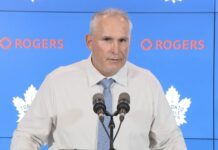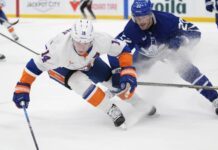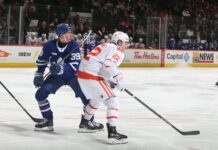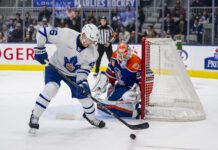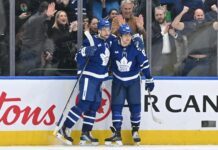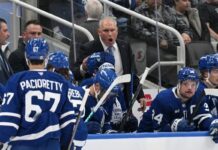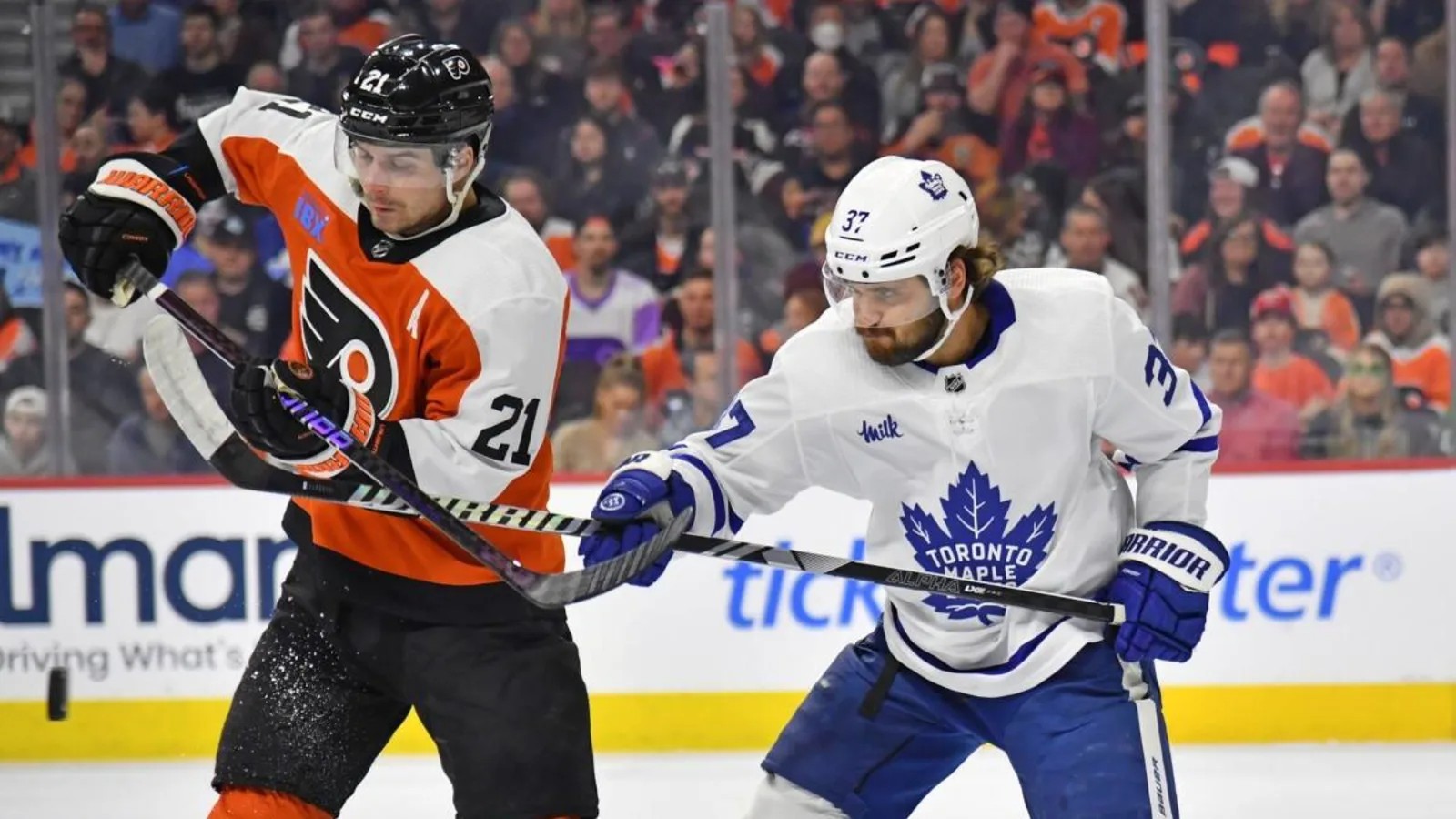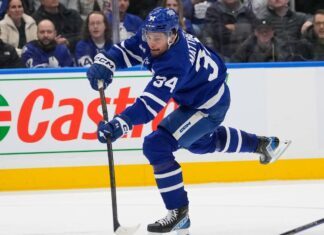The Toronto Maple Leafs beat the qualifying offer buzzer on Sunday afternoon and re-signed D Timothy Liljegren to a two-year contract worth an AAV of $3 million.
The 25-year-old Swede has experienced an up-and-down career since the Maple Leafs drafted him 17th overall back in 2017, one that saw him fail to establish himself in the NHL until his age-22 season in 2021-22. Since that point, Liljegren has played no more than 67 games and no fewer than 55 games in each of the last three seasons, typically on the third pair with a series of partners. In that time, Liljegren has shown that he can perform exceptionally well in that regular season role, but he has been unable to solidify himself as a true top-four defender, and the playoffs have remained a massive challenge for him.
Liljegren was once a heralded draft prospect pegged to the top of boards when the 2016-17 cycle began. However, a bout with mononucleosis during his draft-eligible season helped kick off a tumble down boards, which allowed the Maple Leafs to snag him just outside the lottery in 2017. From there, Liljegren’s development path was uneven, spending most of four seasons with the Toronto Marlies in the AHL, with very occasional trials in the NHL.
Finally, in 2021-22, Liljegren got a crack at regular play with the Leafs at a time when the team had a number of young, possible third-pair defenders alongside Travis Dermott and Rasmus Sandin. That ’22 season saw Liljegren appear in 61 games with 23 points, averaging 16:24 per night. He was a pleasant surprise, posting elite underlying metrics in the regular season as the Leafs dominated Liljegren’s third pair minutes, earning trust from Sheldon Keefe that allowed him to start the first two games of Toronto’s first-round matchup with Tampa Bay on a pair next to Mark Giordano. Those games went rather poorly for Liljegren, who looked overwhelmed by the Lightning’s forecheck, and it led to Keefe scratching the youngster for Game 3. Justin Holl replaced Liljegren when the series shifted back to Tampa, and Liljegren did not return to the lineup.
2022-23 was the closest thing Liljegren has experienced to a full season in Toronto, but even that started slowly. Liljegren dealt with a hernia in the offseason and did not start his season until early November, missing the first month. After returning to the lineup, Liljegren played 67 games, and for a period of time, he looked to be blossoming into a bona fide top-four defenseman. When the Leafs were ravaged by defensive injuries in December, Liljegren and Sandin played together on an all-young, all-Swedish second pair and had success. It seemed like the future had come in the present, but those glimmers of hope quickly faded. The Leafs got healthier, Liljegren’s role was reduced, and then a particularly disastrous game from Liljegren against the mighty Boston Bruins caused then-GM Kyle Dubas to get aggressive at the deadline to revamp his defense.
The team added Luke Schenn, Jake McCabe, and Erik Gustafsson while trading out Sandin. At that point, the Leafs were carrying eight NHL defensemen, and Liljegren found himself on the outside looking in. He was in and out of the lineup with various partners, and his play seemed to suffer (unsurprisingly).
Liljegren couldn’t find any rhythm down the stretch, and Toronto opted to scratch Liljegren to start the playoffs. He jumped back in before Game 6, when the Leafs eliminated Tampa, due to poor play from Justin Holl, but he played barely 10 minutes in that game (which went to OT, as an aside). Liljegren stayed in the lineup on the third pair with Giordano for four of the games against Florida in the next round, but again, he played a sheltered role and failed to make much of an impact.
That set the stage for 2023-24, where much hope was placed on further growth from Liljegren. He started out okay, but on November 3, Liljegren awkwardly collided with the boards after a hit by Brad Marchand and suffered a high-ankle sprain. He was out until mid-December and took some time to get his game back. High-ankle sprains are difficult injuries to recover from during the season, so it is quite possible that Liljegren was still hampered by the ailment all season. Eventually, he found a bit of a groove around the time of Morgan Rielly’s suspension, scoring 14 points in a 16-game span and playing nearly 21 minutes per night. But again, injuries intervened, and Liljegren missed nearly three weeks from late March to mid-April.
The Leafs still believed in him and gave him a lineup spot in the playoffs, where Liljegren played on a third pair with Joel Edmundson but struggled once more, playing nearly 18 minutes per game but logging only a single point and losing the territorial battle on his pair substantially.
That led to the present, when there was much debate over whether the Leafs would tender Liljegren a contract or whether they’d trade him (or not issue a qualifying offer). The team seemed to fear arbitration and the possibility of paying the defenseman well above $3 million. Talks seemed to be on the rocks until just before the 5 p.m. deadline, when the club and player reached an agreement right at $3 million over a two-year deal.
At first glance, this doesn’t appear to be a massive steal for the team (unless Liljegren makes the proverbial leap), but it also isn’t a major steal for the player, either. One could call it a pretty fair deal, then.
The debate with Liljegren is pretty straightforward. He’s only 25, with a lot of “prime” years ahead of him. He’s also a right shot, and the Leafs have only Conor Timmins on the roster besides him (Chris Tanev is likely joining that list imminently). It’s awfully hard to just give up on a mid-20s player at a premium position who has demonstrated success at the NHL level, even just in flashes.
Liljegren has demonstrated, over the course of three seasons, the ability to control easier *regular season* minutes at a clip that few other third-pair defensemen in the NHL can match. Per JFresh Hockey, in 2800+ 5v5 minutes in the past three regular seasons, Liljegren has a 57.8% goal share and 56.4% xGoal share, both among the highest marks in the NHL among blueliners. While most Leafs fans want Liljegren to grow into something more, we shouldn’t ignore that controlling third-pair minutes isn’t nothing.
Liljegren also brings attributes that the Leafs don’t have a ton of otherwise. He moves the puck decently well. When healthy, he’s a decent skater and transitional defenseman. Liljegren has played PP2 some in his career and has played the PK some as well. There is the opportunity for potential. His time on ice has grown each of the last three seasons, and now he will have the opportunity to be coached by a new bench boss in Craig Berube, who can presumably bring fresh ideas and tactics to try to improve Liljgren’s game. His struggles in the playoffs remain very real, as is his lack of an imposing physical game and concerns about his processing speed/ability when handling heavy forechecks. But it’s worth remembering that he still has played fewer than 200 NHL games and only 13 total playoff games.
There have been glimpses in each of the last two seasons of Liljegren growing into a real top-four defenseman, and betting a reasonably low term and low AAV contract on the possibility that could happen is probably worth it. The risk isn’t terribly high; thus, the possible reward justifies the transaction. If Liljegren never grows beyond a third-pair player, a $3 million cap hit is fine in the context of a rising cap, and if it’s too pricey, he should have some trade value — although, in the worst-case scenario, a $3 million defenseman who ends up scratched in the playoffs again is far from ideal. If he does make a big jump, then the Leafs could glean temporary surplus value out of the deal. I don’t see anything terribly wrong with doing this, especially considering that some outrageous contracts could be handed out tomorrow in unrestricted free agency.
The Leafs now have six defensemen on the roster, only five signed for next year. The signed players are Morgan Rielly, Jake McCabe, Timothy Liljegren, Simon Benoit, and Conor Timmins, while Chris Tanev is on the team but not yet signed, with the expectation that he will be signed in the next 18 hours before noon tomorrow. You’d like to add at least one more player to that group who is, ideally, a legitimate top-four defender, although that may not be easy to do.
Nikita Zadorov, Matt Roy, and Oliver Ekman-Larsson remain some of the bigger names, but it’s possible that Toronto could be looking at the more undervalued tier. Only time will tell, but with Tanev acquired, Domi extended, and now Liljegren signed, the picture for the 2024-25 Maple Leafs is starting to come into focus.


